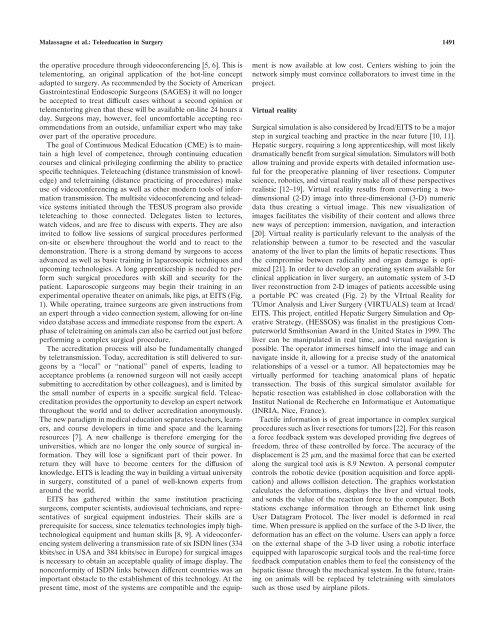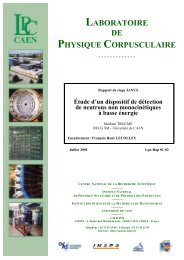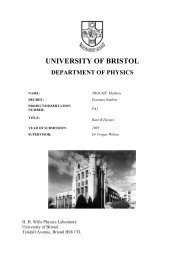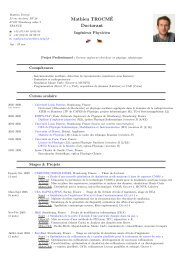European Institute for TeleSurgery Experience - Free
European Institute for TeleSurgery Experience - Free
European Institute for TeleSurgery Experience - Free
You also want an ePaper? Increase the reach of your titles
YUMPU automatically turns print PDFs into web optimized ePapers that Google loves.
Malassagne et al.: Teleeducation in Surgery 1491<br />
the operative procedure through videoconferencing [5, 6]. This is<br />
telementoring, an original application of the hot-line concept<br />
adapted to surgery. As recommended by the Society of American<br />
Gastrointestinal Endoscopic Surgeons (SAGES) it will no longer<br />
be accepted to treat difficult cases without a second opinion or<br />
telementoring given that these will be available on-line 24 hours a<br />
day. Surgeons may, however, feel uncom<strong>for</strong>table accepting recommendations<br />
from an outside, unfamiliar expert who may take<br />
over part of the operative procedure.<br />
The goal of Continuous Medical Education (CME) is to maintain<br />
a high level of competence, through continuing education<br />
courses and clinical privileging confirming the ability to practice<br />
specific techniques. Teleteaching (distance transmission of knowledge)<br />
and teletraining (distance practicing of procedures) make<br />
use of videoconferencing as well as other modern tools of in<strong>for</strong>mation<br />
transmission. The multisite videoconferencing and teleadvice<br />
systems initiated through the TESUS program also provide<br />
teleteaching to those connected. Delegates listen to lectures,<br />
watch videos, and are free to discuss with experts. They are also<br />
invited to follow live sessions of surgical procedures per<strong>for</strong>med<br />
on-site or elsewhere throughout the world and to react to the<br />
demonstration. There is a strong demand by surgeons to access<br />
advanced as well as basic training in laparoscopic techniques and<br />
upcoming technologies. A long apprenticeship is needed to per<strong>for</strong>m<br />
such surgical procedures with skill and security <strong>for</strong> the<br />
patient. Laparoscopic surgeons may begin their training in an<br />
experimental operative theater on animals, like pigs, at EITS (Fig.<br />
1). While operating, trainee surgeons are given instructions from<br />
an expert through a video connection system, allowing <strong>for</strong> on-line<br />
video database access and immediate response from the expert. A<br />
phase of teletraining on animals can also be carried out just be<strong>for</strong>e<br />
per<strong>for</strong>ming a complex surgical procedure.<br />
The accreditation process will also be fundamentally changed<br />
by teletransmission. Today, accreditation is still delivered to surgeons<br />
by a “local” or “national” panel of experts, leading to<br />
acceptance problems (a renowned surgeon will not easily accept<br />
submitting to accreditation by other colleagues), and is limited by<br />
the small number of experts in a specific surgical field. Teleaccreditation<br />
provides the opportunity to develop an expert network<br />
throughout the world and to deliver accreditation anonymously.<br />
The new paradigm in medical education separates teachers, learners,<br />
and course developers in time and space and the learning<br />
resources [7]. A new challenge is there<strong>for</strong>e emerging <strong>for</strong> the<br />
universities, which are no longer the only source of surgical in<strong>for</strong>mation.<br />
They will lose a significant part of their power. In<br />
return they will have to become centers <strong>for</strong> the diffusion of<br />
knowledge. EITS is leading the way in building a virtual university<br />
in surgery, constituted of a panel of well-known experts from<br />
around the world.<br />
EITS has gathered within the same institution practicing<br />
surgeons, computer scientists, audiovisual technicians, and representatives<br />
of surgical equipment industries. Their skills are a<br />
prerequisite <strong>for</strong> success, since telematics technologies imply hightechnological<br />
equipment and human skills [8, 9]. A videoconferencing<br />
system delivering a transmission rate of six ISDN lines (334<br />
kbits/sec in USA and 384 kbits/sec in Europe) <strong>for</strong> surgical images<br />
is necessary to obtain an acceptable quality of image display. The<br />
noncon<strong>for</strong>mity of ISDN links between different countries was an<br />
important obstacle to the establishment of this technology. At the<br />
present time, most of the systems are compatible and the equip-<br />
ment is now available at low cost. Centers wishing to join the<br />
network simply must convince collaborators to invest time in the<br />
project.<br />
Virtual reality<br />
Surgical simulation is also considered by Ircad/EITS to be a major<br />
step in surgical teaching and practice in the near future [10, 11].<br />
Hepatic surgery, requiring a long apprenticeship, will most likely<br />
dramatically benefit from surgical simulation. Simulators will both<br />
allow training and provide experts with detailed in<strong>for</strong>mation useful<br />
<strong>for</strong> the preoperative planning of liver resections. Computer<br />
science, robotics, and virtual reality make all of these perspectives<br />
realistic [12–19]. Virtual reality results from converting a twodimensional<br />
(2-D) image into three-dimensional (3-D) numeric<br />
data thus creating a virtual image. This new visualization of<br />
images facilitates the visibility of their content and allows three<br />
new ways of perception: immersion, navigation, and interaction<br />
[20]. Virtual reality is particularly relevant to the analysis of the<br />
relationship between a tumor to be resected and the vascular<br />
anatomy of the liver to plan the limits of hepatic resections. Thus<br />
the compromise between radicality and organ damage is optimized<br />
[21]. In order to develop an operating system available <strong>for</strong><br />
clinical application in liver surgery, an automatic system of 3-D<br />
liver reconstruction from 2-D images of patients accessible using<br />
a portable PC was created (Fig. 2) by the VIrtual Reality <strong>for</strong><br />
TUmor Analysis and Liver Surgery (VIRTUALS) team at Ircad/<br />
EITS. This project, entitled Hepatic Surgery Simulation and Operative<br />
Strategy, (HESSOS) was finalist in the prestigious Computerworld<br />
Smithsonian Award in the United States in 1999. The<br />
liver can be manipulated in real time, and virtual navigation is<br />
possible. The operator immerses himself into the image and can<br />
navigate inside it, allowing <strong>for</strong> a precise study of the anatomical<br />
relationships of a vessel or a tumor. All hepatectomies may be<br />
virtually per<strong>for</strong>med <strong>for</strong> teaching anatomical plans of hepatic<br />
transsection. The basis of this surgical simulator available <strong>for</strong><br />
hepatic resection was established in close collaboration with the<br />
Institut National de Recherche en In<strong>for</strong>matique et Automatique<br />
(INRIA, Nice, France).<br />
Tactile in<strong>for</strong>mation is of great importance in complex surgical<br />
procedures such as liver resections <strong>for</strong> tumors [22]. For this reason<br />
a <strong>for</strong>ce feedback system was developed providing five degrees of<br />
freedom, three of these controlled by <strong>for</strong>ce. The accuracy of the<br />
displacement is 25 �m, and the maximal <strong>for</strong>ce that can be exerted<br />
along the surgical tool axis is 8.9 Newton. A personal computer<br />
controls the robotic device (position acquisition and <strong>for</strong>ce application)<br />
and allows collision detection. The graphics workstation<br />
calculates the de<strong>for</strong>mations, displays the liver and virtual tools,<br />
and sends the value of the reaction <strong>for</strong>ce to the computer. Both<br />
stations exchange in<strong>for</strong>mation through an Ethernet link using<br />
User Datagram Protocol. The liver model is de<strong>for</strong>med in real<br />
time. When pressure is applied on the surface of the 3-D liver, the<br />
de<strong>for</strong>mation has an effect on the volume. Users can apply a <strong>for</strong>ce<br />
on the external shape of the 3-D liver using a robotic interface<br />
equipped with laparoscopic surgical tools and the real-time <strong>for</strong>ce<br />
feedback computation enables them to feel the consistency of the<br />
hepatic tissue through the mechanical system. In the future, training<br />
on animals will be replaced by teletraining with simulators<br />
such as those used by airplane pilots.






